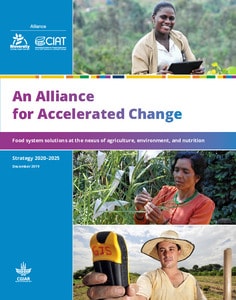Our planet – both humans and the natural world – faces four global crises of relevance to the Alliance of Bioversity International and the International Center for Tropical Agriculture (CIAT): climate change, biodiversity loss, environmental degradation, and the so-called triple burden of malnutrition – hunger, nutrient deficiencies, and overnutrition. Food systems are both a victim of these crises – climate change, for example, is driving down productivity of agricultural systems around the world – and a culprit – with agriculture and related land uses accounting for 23 percent of human greenhouse gas emissions and a major driver of habitat and biodiversity loss. But this doesn’t have to be so. The Alliance of Bioversity International and CIAT is a new venture created to turn food and agriculture systems around. This, the Alliance’s first unified strategy, combines the strengths of the two organizations – including genebanks, use and conservation of agricultural and tree biodiversity, climate-smart agriculture, nutrition, digital agriculture, crop improvement, and participatory research approaches – to develop solutions to these crises, through a clear focus on working at the nexus of agriculture, environment, and nutrition. The strategy has been designed from the outset for impact at scale, from local to global levels, through a range of partnerships and new business models that change our relationships with key development actors from next users to partners, co-investors, and clients. We have a vision of food systems and landscapes that sustain the planet, drive prosperity, and nourish people. To achieve this, our mission is to deliver research-based solutions that harness agricultural biodiversity and sustainably transform food systems to improve people’s lives in a climate crisis. We will achieve our mission through four strategic objectives: 1. People consume diverse, nutritious, and safe foods. 2. People participate in and benefit from inclusive, innovative, and diversified agri-food markets. 3. People sustainably manage farms, forests, and landscapes that are productive and resilient to climate change. 4. Communities and institutions sustainably use and safeguard agricultural biodiversity. The Alliance will achieve this new, holistic vision by employing approaches such as innovation networks and communities of practice and by fostering new alliances and partnerships with investors, the private sector, disruptive innovators, and the like that build on our existing networks. We will also create novel ways to integrate our scientists and our partners in result-oriented teams that will deliver the outcomes the Alliance envisages and contribute to the 2030 Research Strategy of One CGIAR. The strategy is organized around six ‘levers of change’ that will, applied judiciously, transform food systems and landscapes to meet the challenges of the burgeoning demand for more-nutritious food while maintaining and improving our environment and addressing climate change. These are pressure points where Alliance research can play a catalytic role, and our intervention can trigger multiplier effects for positive change.

